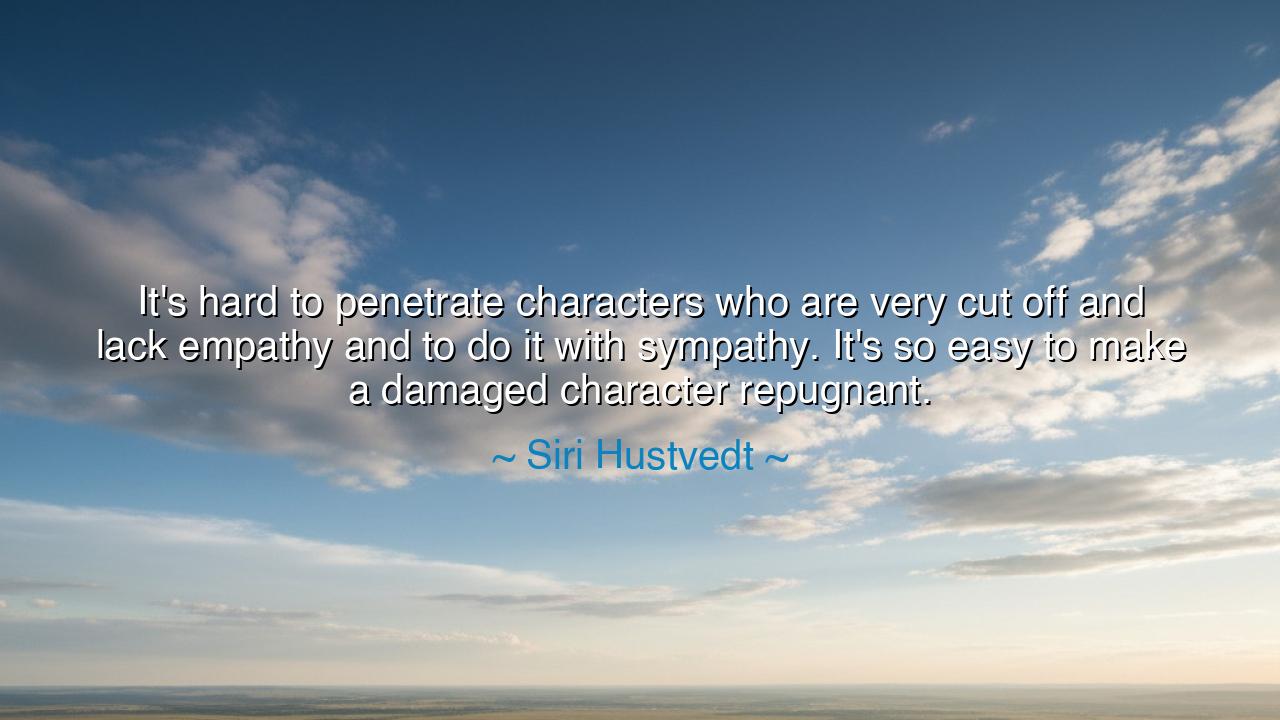
It's hard to penetrate characters who are very cut off and lack
It's hard to penetrate characters who are very cut off and lack empathy and to do it with sympathy. It's so easy to make a damaged character repugnant.






When Siri Hustvedt declared, “It's hard to penetrate characters who are very cut off and lack empathy and to do it with sympathy. It's so easy to make a damaged character repugnant,” she was speaking as both an artist and a seeker of truth. For her words touch the essence of storytelling, and indeed of life itself: the difficulty of looking into the soul of the wounded without recoiling, of finding the fragile humanity beneath the mask of hardness. In these words lies a lesson in sympathy, in patience, and in the refusal to turn away from those who are broken.
The heart of her statement is the acknowledgment that it is easy to condemn those who are damaged. A character who is cold, withdrawn, or without empathy naturally invites our scorn. Their walls are high, their gestures harsh, their silence unyielding. To portray them without care—or to view them without effort—is to risk dehumanizing them, reducing them to mere villains, caricatures of cruelty. Yet Hustvedt insists that the harder task, the nobler task, is to approach them with sympathy—to see not only their outward coldness but the unseen wound that shaped it.
History itself gives us an example in the figure of King Lear. At the beginning of Shakespeare’s tragedy, Lear is vain, blind to truth, and cruel to the one daughter who loves him most. It would be easy to despise him, to see only arrogance and folly. But as the play unfolds, we see the fragility beneath his rage—the old man broken by betrayal, clinging desperately to dignity as the storm of fate engulfs him. By the end, we weep not only for Cordelia, but for Lear himself, because Shakespeare, like Hustvedt, shows us how to see the broken without stripping them of humanity.
The artist’s challenge, then, is also the challenge of the human soul: to see the damaged with compassion. For in every harsh exterior lies a story untold—trauma, loss, fear, or longing that carved away tenderness. To make such a character repugnant is easy, but to make them understandable, to let the audience glimpse the child within the tyrant or the wound within the sinner, is the mark of wisdom. Sympathy does not excuse their faults, but it refuses to abandon their humanity.
The lesson is not only for writers, but for all who live in community with others. Each of us encounters those who seem closed, harsh, or cold. It is tempting to dismiss them, to see only their roughness. But Hustvedt calls us to a higher vision: to ask what wound they carry, what fear has hardened them, what loneliness lies behind their silence. In doing so, we learn to respond not with hatred, but with patience and empathy, even when they offer little of it in return.
Practical action lies here: when you face someone difficult, resist the urge to make them “repugnant” in your mind. Instead, practice the discipline of sympathy. Listen longer, imagine deeper, and remember that the exterior often hides more than it reveals. If you are a creator, seek to portray damaged characters with honesty but also with compassion, allowing their humanity to shine even in their brokenness. If you are simply a friend, parent, or companion, let this truth shape your dealings with others: behind every hardness lies a wound.
Therefore, let Hustvedt’s words stand as a guide for artists and for all seekers of wisdom: it is not greatness to scorn the broken, but greatness to see their humanity without excusing their faults. The world will always find it easy to condemn, but the task of the wise is harder—to look deeper, to understand, and to hold even the most cut off souls within the embrace of sympathy. For in doing so, we honor not only them, but also the fragility that lives within ourselves.






AAdministratorAdministrator
Welcome, honored guests. Please leave a comment, we will respond soon